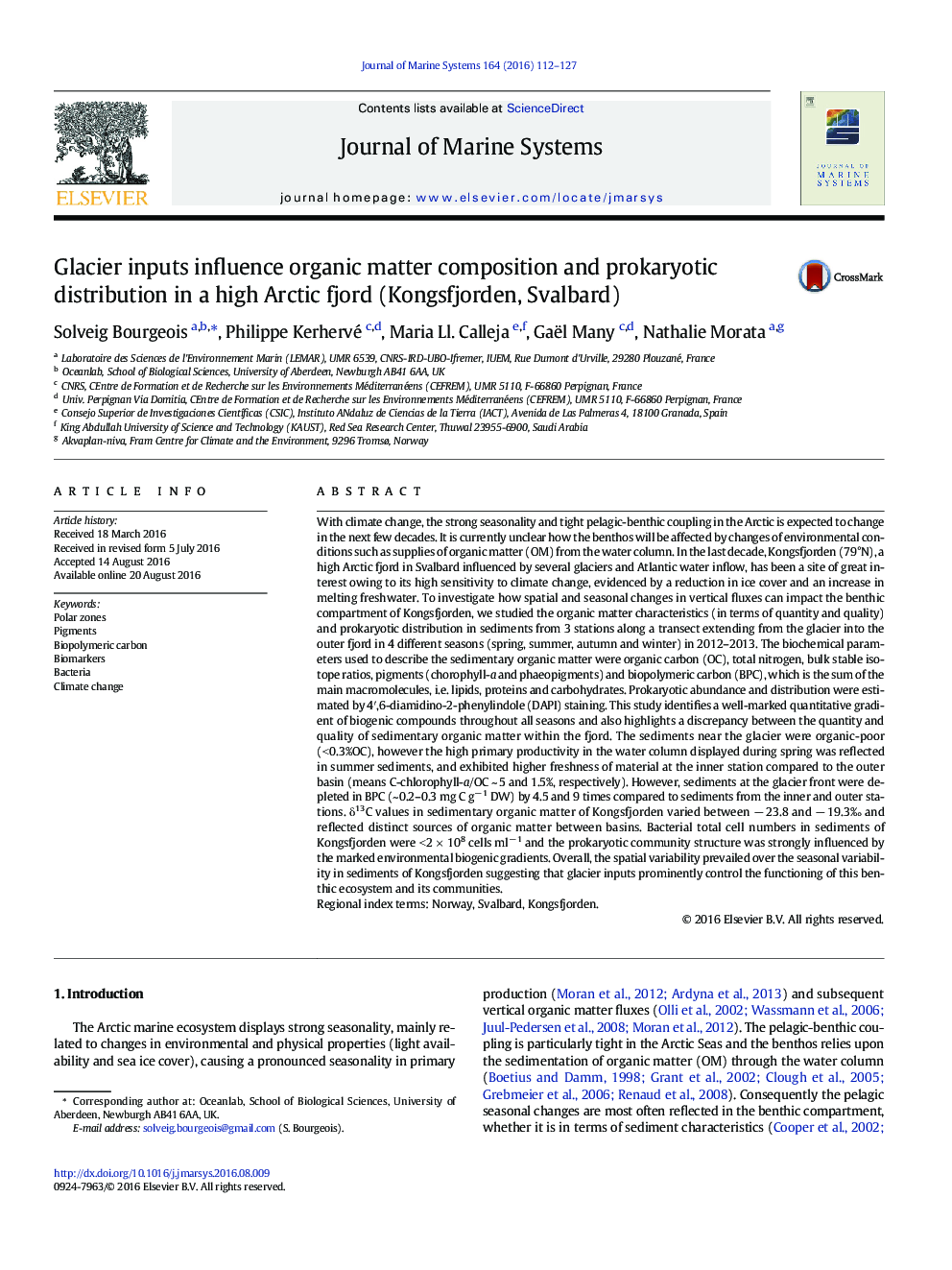| کد مقاله | کد نشریه | سال انتشار | مقاله انگلیسی | نسخه تمام متن |
|---|---|---|---|---|
| 4547847 | 1627266 | 2016 | 16 صفحه PDF | دانلود رایگان |
• Organic matter quantity, quality and sources were spatially and seasonally examined.
• Well-marked glacier-outer fjord quantitative gradients of OM throughout all seasons
• Spring events of surface primary production well recorded in sediments
• Discrepancy between quantity and quality of the sedimentary OM within the fjord
• Biogenic gradients influenced the prokaryotic distribution in the sediments.
• Spatial variability prevailed over seasonal variability in Kongsfjorden's sediments.
With climate change, the strong seasonality and tight pelagic-benthic coupling in the Arctic is expected to change in the next few decades. It is currently unclear how the benthos will be affected by changes of environmental conditions such as supplies of organic matter (OM) from the water column. In the last decade, Kongsfjorden (79°N), a high Arctic fjord in Svalbard influenced by several glaciers and Atlantic water inflow, has been a site of great interest owing to its high sensitivity to climate change, evidenced by a reduction in ice cover and an increase in melting freshwater. To investigate how spatial and seasonal changes in vertical fluxes can impact the benthic compartment of Kongsfjorden, we studied the organic matter characteristics (in terms of quantity and quality) and prokaryotic distribution in sediments from 3 stations along a transect extending from the glacier into the outer fjord in 4 different seasons (spring, summer, autumn and winter) in 2012–2013. The biochemical parameters used to describe the sedimentary organic matter were organic carbon (OC), total nitrogen, bulk stable isotope ratios, pigments (chorophyll-a and phaeopigments) and biopolymeric carbon (BPC), which is the sum of the main macromolecules, i.e. lipids, proteins and carbohydrates. Prokaryotic abundance and distribution were estimated by 4′,6-diamidino-2-phenylindole (DAPI) staining. This study identifies a well-marked quantitative gradient of biogenic compounds throughout all seasons and also highlights a discrepancy between the quantity and quality of sedimentary organic matter within the fjord. The sediments near the glacier were organic-poor (< 0.3%OC), however the high primary productivity in the water column displayed during spring was reflected in summer sediments, and exhibited higher freshness of material at the inner station compared to the outer basin (means C-chlorophyll-a/OC ~ 5 and 1.5%, respectively). However, sediments at the glacier front were depleted in BPC (~ 0.2–0.3 mg C g− 1 DW) by 4.5 and 9 times compared to sediments from the inner and outer stations. δ13C values in sedimentary organic matter of Kongsfjorden varied between − 23.8 and − 19.3‰ and reflected distinct sources of organic matter between basins. Bacterial total cell numbers in sediments of Kongsfjorden were < 2 × 108 cells ml− 1 and the prokaryotic community structure was strongly influenced by the marked environmental biogenic gradients. Overall, the spatial variability prevailed over the seasonal variability in sediments of Kongsfjorden suggesting that glacier inputs prominently control the functioning of this benthic ecosystem and its communities.Regional index terms: Norway, Svalbard, Kongsfjorden.
Journal: Journal of Marine Systems - Volume 164, December 2016, Pages 112–127
